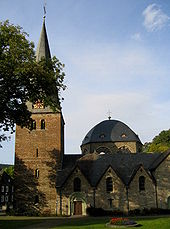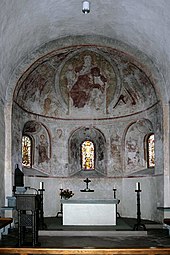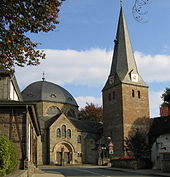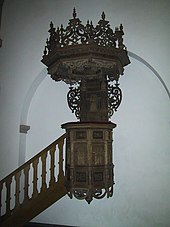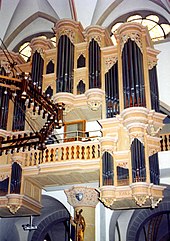St. Blaise (Balve)
The parish church of St. Blaise in Balve has been consecrated to St. Blaise of Sebaste and the Blessed Mother Mary since the 13th century . In 1430 Balve received city rights from Elector Dietrich II of Cologne . The Balver parish church was located outside the city fortifications and was originally part of the "Oberhof".
In the possession of the parish there is a reliquary with relics of St. Blaise and a folding altar with relics of Benedict of Nursia . Balve belongs to the Archdiocese of Paderborn .
The building association St. Blasius is committed to the maintenance of the church.
history
Parish
The first clergy mentioned in a document was Elbertus (also Albertus ) de Balleve (1202). According to Johannes Ruhrmann, the year of Christianization of the upper Hönnetal cannot be precisely determined. The second half of the 9th century is assumed. The lack of historical information could, however, be regarded as indirect evidence of the parish's old age.
The parish was mentioned for the first time in 1196: “two houses in Brockhausen in the parish of Balve” (confirmation from Pope Coelestin III opposite the Scheda monastery ).
J. Ruhrmann dates the construction of the three-aisled Romanesque hall church in its oldest parts to the 12th century.
In 1550, Henneke Schungell, Landdrost of the Archbishopric of Cölln, founded the hospital or poor house in Balve (later also called "in the Holy Spirit"). Initially four, later eight poor people found accommodation and livelihood there. The hospital building at the end of Hospitalgasse was demolished around 1870. In 1556 Johannes Köster ("Kustodis") fled from the Archbishop of Cologne Gebhard Truchsess , "because they did not want to be tempted by Caspar Mothäus, Dücker and other Truchsessian visitors to change the old religion" . Truchsess was considered a church robber and iconoclast for Westphalia. The "religious zealous" Hermann von Hatzfeld felt his revenge when his Wocklum Castle was set on fire. All the chapels in the parish of Balve were desecrated.
In 1583, Clemens Duwenheuer ("Dumnenhover"), vicar of Affeln, had to flee from Gebhard Gebhard I. Truchsess because of his steadfastness in faith . He went to Allendorf and was killed by church robbers. The robbery murderers were discovered in an Attendorn inn, convicted of their crime and executed on the gallows on the Rappelsberg near Attendorn.
During the Seven Years' War, Balve was occupied for ten days by the French, who opened a field bakery and butcher shop in the churchyard on June 24, 1761. For this purpose, the 2.5 m high churchyard wall was “broken from the ground”, the pews were torn from the church, and the flour magazine was moved to the church. All the trees were felled. 42 large ovens were built, each oven with three chimneys. During this time, the service took place in the mausoleum, the so-called "Wocklumer House". The French occupation took part. It had a "special effect" on the Balver when the whole French regiment sang the Veni creator spiritus .
On December 11, 1803, the relics of the Three Kings appeared in Balve. In 1794, before the French marched into Cologne, they were brought to safety in Wedinghausen near Arnsberg, and when they were transported back to Cologne via Balve they were housed for one night in the private house of Glasmacher (today the “Drei Könige” inn). The secret operation leaked. The next day a procession from Balvern followed the relics on their way towards Cologne.
In 1818 the church received a new organ with illumination (painting) and bellows. It cost about 1,500 Rtlr. The city chapel was demolished because it had become a traffic obstacle and dilapidated. The stones were used to build the Holy House on the Husenberg. In 1856 a new burial place was put into use in the cemetery.
The pastors
In 1214 Elbertus de Balleve was the first pastor of Balve known by name. (Evidence from 1214–1933: cf.)
Around 1285 a Gerardus de Balleve is mentioned. In 1356 there is a Hermannus pastor according to a document from the Balver parish archives with a declaration of interest obligation ( “And I Hermann by the grace of God confess a pastor to Balve ...” ; 1353 - document issued in Avignon, which gives visitors to the parish church an indulgence and certain conditions granted).
Herrmann Wrede, pastor from 1475 to 1482, received the parish of Balve as canon of the Scheda monastery. In 1509 Johann Lösse followed and from 1512 Johann Korte, recorded on a deed of donation for the chapel in the Klause (opposite the Balver cave, today Nitsche).
Antonius Prätorius was pastor from 1600 to 1614. He received disciplinary measures for private excesses and disobedience. He was followed by Henricus Nevenius from 1615 to 1620. He was warned about a casual lifestyle on the occasion of a general visit. He pioneered the later witch hunt.
Hermann Laer was pastor from 1621 to 1636. A witch hunt raged under him from autumn 1628 to the end of 1630, about which not only records from the Balver pastor, but also especially from Pastor Eberhard Wiede zu Enkhausen, are available in the parish archives. 74 people were executed within four months. Clergy from the parishes in question usually met in Balve beforehand to “serve” the prisoners, i. H. to give them consolation, to provide spiritual assistance and to enable them to receive the sacraments.
Auxiliary Bishop Bernhard Frick followed in 1647. Between June 30, 1647 and June 8, 1647, he undertook the confirmation of 350 parishioners after the high mass and the consecration of five altars in the Michael's chapel at the town hall and chapels in Eisborn, Mellen, Affeln. After the end of the Thirty Years' War there were only 656 baptisms, 33 births per year in the entire large parish until 1667. There were still 43 houses in Balve.
Three Protestants were resident in Balve at this time: Mr. von Haxthausen zu Eisborn with his wife, and Mr. von Mengede in Garbeck.
From 1662 to 1683 Johannes Matthäus Höynck (* 1635; † 1683), son of the electoral judge of Balve, was pastor in Balve and dean for Attendorn. Several meetings of the deanery were held in Balve under his leadership.
In 1691 Johannes Karl Höynck (* 1654; † 1691, brother of J. Matthäus) created the third church book. He contracted red dysentery when the holy sacraments were administered, to which he succumbed on October 10, 1691. He was buried in the choir of the church.
His successor was Johann. Eberhard Gödde († 1733) as dean. In 1716 there were 1,500 communicants in the parish. In 1720–1722 four new bells were purchased because the old ones had broken. Franz Anton Brunswicker (* 1752; † 1844, son of the clerk) was pastor from 1801 to 1844. In 1812 he built a new school in Balve and in 1822 the new sexton's house.
Franz Anton Wulff (* 1805 in Langenholthausen) was pastor from 1844 to 1875. After Wulff's death, the parish was orphaned for years due to the Kulturkampf; all parish acts were omitted. In 1886 the founder of the new hospital in Marienhospital, Vicar Arens, died. The hospital was opened on January 23, 1890 in the Arens house.
Albert Schneider (* 1836; † 1908) was pastor from 1886 to 1908. He was a very popular pastor and collected the funds for the planned new church and had the plan for the church drawn up. "He was considered one of the most learned theologians in the diocese."
Franz Amecke (* 1861; † 1933) was pastor from 1908 to 1933 and was made an honorary citizen by the city of Balve in 1930. "Dean Amecke was known for his affability and originality."
His successor from 1933 to 1958 was Wilhelm Boeddicker, also an honorary citizen of the city of Balve. "The zealous prayer and pastor led his parish through the years of the Third Reich with wisdom and courage" (quotations from).
Josef Löcker (* 1908; † 2010) was pastor from 1958 to 1977. He was an honorary dean of the Balve dean's office.
Ludwig Kinkel worked as a pastor from 1977 to 2000.
He was followed by Dr. Reinhard Richter (2000 to 2009). Due to structural changes within the Archdiocese of Paderborn, he has also been in charge of the parishes of St. Nikolaus Beckum and St. Antonius Einsiedler Eisborn since 2007. The parishes together form the pastoral association Balver Land, which belongs to the deanery Märkisches Sauerland .
In 2009, the priest Andreas Schulte (born January 5, 1965 in Neheim ) from Neheim took up the parish in Balve.
Church and inventory
Romanesque church
The parish church consists of two parts, a Romanesque church from the 10th / 12th. Century and the large neo-Romanesque extension from 1910.
The three-aisled nave was built by the owner of an Oberhof in Balve. Either Count Heinrich I von Arnsberg or Count Ruprecht II von Nassau come into question here . The church was then expanded again and again from the 12th century and contains some special features that are not apparent at first glance.
To the right of the apse there is a culturally and historically significant depiction of the legend of Nicholas of Myra . The west-facing portal, which is no longer used today, now houses a tower chapel with a statue of the Virgin Mary with child and four priest grave slabs.
The windows of the old church show in the aisle St. Liborius , St. Agatha of Catania and St. Anthony of Padua .
The old organ, the wooden front of which was built in 1786, can be operated with its ten stops from its own console or from the central console of the new organ.
The epitaph from 1603 is dedicated to Hermann von Hatzfeld , the Cologne Electorate, Droste zu Balve and successful "opponent" of Gebhard Truchsess von Waldburg during the so-called Truchsess confusion . Balve subsequently remained Catholic.
apse
The apse is determined by an elaborate fresco painting from the 13th century and is said to have originated around the year 1000. In the east-facing apse, windows show the tools of the Passion and a picture of the Cross of Christ made by the painter Heinrich Strodtmann based on a template by Albrecht Dürer and copper engraver Sadeler , in which Hermann von Hatzfeld is also said to be depicted.
Portals and jewelry
Neo-Romanesque new building
The neo-Romanesque extension from 1910 was designed under the aegis of Pastor Albert Schneider by Professor Joseph Buchkremer , master builder in Aachen, and carried out under his direction (construction began in 1908). The new building was consecrated by dean Franz Amecke on June 30, 1912. The idea of the Carolingian octagon was also implemented by Buchkremer in the Bödefeld church, which was built around the same time .
architecture
The large dome with the octagon defines the expansive new building.
The dome was designed according to its models such as the Dome of the Rock in Jerusalem in the shape of an unequal-sided octagon with an irregular hexagon as a side aisle-like approach. There are strong round pillars at the eight corners.
window
The windows of the dome contain the eight Beatitudes . The other windows of the church show symbols of the Creed, an image of St. Ambrose of Milan and St. Gregory the Great and parables. Some windows were destroyed in the war and have been replaced by stealthy, unpainted windows.
altar
The north-facing sanctuary is dominated by the baroque altar, which originally stood in the apse of the old church and in earlier centuries had four side altars that no longer exist. There is an inscription on the predella that refers to the date of origin: Anno 1696, 16 novembris - Hoc Altare Erectum et illuminatum sub pastore Joanne Eberardo godden et pictum from Alexandro Strodtmann (this altar was erected and designed on November 16, 1696 under pastor Johannes Eberhard Gödde and painted by Alexander Strodtmann.)
On the right of the high altar is a late Gothic figure of St. Blasius and on the left a figure of St. Sebastian.
pulpit
To the right of the altar, on the north-east side, a precious Renaissance pulpit from 1545 dominates the scene. The carvings show Christ in the middle and the four occidental Doctors of the Church: Ambrosius, Augustine, Gregor the Elder. Great and Jerome.
characters
In the side part on the north wall there is a late Gothic statue of the Virgin Mary Queen with Child and to the left of it on the west wall a crucifixion with a crucifixion group. Further to the left of it in a side chapel is a Pietà and a grave slab from the grave of Dean Amecke.
In the right side part there is a baroque figure of Blasius. There has been a niche to the left of the figure since the 1990s. In this niche there was a reliquary with relics of St. Blasius. This reliquary was acquired after another was stolen in the 1970s. In June 2011 the new reliquary was stolen.
On the south side, on the middle pillar below the organ, there is another figure of Blasius (around 1900).
Each of the pillars of the church is adorned with a figure of a saint. In addition to the four evangelists, St. Joseph St. Liborius and the Archangel Michael.
organ
In the south, as it were as a transition to the old church, there is a large organ , which was built in 1912 by the Anton Feith company from Paderborn with the help of church music director Theodor Pröpper , the organist at the time. Conversions took place in 1932, 1952 (both from Feith) and 1962 (from Stockmann). In addition, in the course of the renovation work in the 1980s, the organ was rebuilt by the Stockmann brothers organ builder from Werl and moved to its current position as a swallow's nest organ and inaugurated on November 6, 1983. The organ includes a special feature, a tab "Celesta" ( carillon ), which was installed on the wishes Theodor Pröppers.
The organ system now has three manuals and a pedal . The carillon can be played from the upper manual, as well as the baroque organ in the old church. The baroque organ has its own console; it has a pedal register Subbass 16 ', which is not connected to the main console of the organ system.
|
|
|
|
|||||||||||||||||||||||||||||||||||||||||||||||||||||||||||||||||||||||||||||||||||||||||||||||||||||||||||||||||||||||||||||
- Coupling: I / II, III / I, III / II, I / P, II / P, III / P
Steeple
The tower with its more than 20 meter high masonry is built over the tower chapel, the former main portal. The tower stump is crowned by a 28 meter high spire. The tower is believed to have been built around 1480. ( Radiocarbon dating C 14, University of Cologne , November 2006). The total height of the tower is 40.15 meters.
The tower, which was also used as a defense tower in earlier times, is, together with the entire system of the old church, a typical testimony to the Westphalian Romanesque .
Bells
St. Blasius has nine bells , which are distributed on the west tower and roof turret above the choir; two bells on the spire serve to strike the clock . Three bells from the baroque period have survived. The Johannes bell was cast by a predecessor of the Rincker bell foundry, which still exists today, and is one of the oldest surviving bells in this foundry. The Sebastian bell is an instrument of the busy Lorraine workshop de la Paix , which is also active in Eslohe . Both bells, especially the Rincker bell, have an extremely thin rib. Albert Junker's bells are made of the so-called Brilon special bronze (tin-free alloy with silicon ) and have different sound quality. They complement the old stock to create an audibly warped striking note line; the large Blasius bell came out of the cast almost half a tone too high and can be heard more as h 0 than a b 0 . It was planned for all bells to tune them 3/16 whole tones (= 6/16 HT) higher.
| No. |
Surname |
Casting year |
Foundry, casting location |
Mass (kg) |
Percussive ( HT - 1 / 16 ) |
tower |
|---|---|---|---|---|---|---|
| 1 | Blasius | 1946 | Albert Junker, Brilon | 3.131 | b 0 +11 | West tower |
| 2 | Maria | 1946 | Albert Junker, Brilon | 1,824 | of 1 +5 | West tower |
| 3 | Johannes, death knell | 1716 | Johann Jakob Rincker, Asslar | 698 | it 1 | West tower |
| 4th | Sebastian | 1720 | Johann G. de la Paix, Eslohe | 607 | ges 1 -2 | West tower |
| 5 | Barbara, angelus bell | 1946 | Albert Junker, Brilon | 530 | as 1 +9 | West tower |
| 6th | Nicholas | 1946 | Albert Junker, Brilon | 380 | b 1 +5 | West tower |
| 7th | Caecilia, Kleppglocke | 1926 | Humpert (Junker & Edelbrock), Brilon | it 2 | Roof turret | |
| I. | Anna, chime on the hour | 1703 | ? | 198 | it 2 | Spire |
| II | Quarter bell | 1946 | Albert Junker, Brilon | 95 | ges 2 | Spire |
Churchyard and other buildings
For centuries, the churchyard was the parish cemetery. According to careful calculations, 50,000 people were buried here before a new cemetery was opened in 1857. The old mausoleum, the burial place of the family of Landdrosten Henneke-Schüngel, has stood between the church and the rectory for over 400 years. The church square is rounded off by the war memorial and two buildings ( day care center and “old girls' school” ), which today serve as a meeting place for the local rifle brotherhood.
- Pius Chapel
The so-called Pius Chapel is also owned by the parish. It is located on the Balver Husenberg and became Pope Pius IX. consecrated. Blessed in 1878, the building went back to an initiative of Vicar Christoph Adrian, who also used his private fortune to push this building under the influence of the Kulturkampf . There is a Russian military cemetery next to the Pius Chapel.
The community's harvest festival is celebrated at the Pius Chapel. The Pius Chapel is also available for weddings .
- Sexton's house
The sexton's house from 1822 served as the home of the family of the organist and church music director Theodor Pröpper . It is structurally connected to the parish hall of the community. It was possible to save the building from demolition against the bitter resistance of the Archdiocese of Paderborn. Today the sexton's house houses the office of the local branch of the Malteser Aid Service .
- Cemetery views
literature
- Werner Ahrens: Balve and his Romanesque legacy. Heimwacht Balve, Balve 2006, ISBN 3-89053-109-1 .
- Franz Anton Höynck: History of the parishes of the deanery Arnsberg .
- Roland Pieper (Ed.): St. Blasius in Balve. Architecture in the field of tension between Romanesque and historicism . Association for the preservation of the parish church of St. Blasius Balve, Balve 2011, ISBN 978-3-89053-129-8 .
Individual evidence
- ^ A b J. Ruhrmann: Contributions to the chronicle of the parish of Balve. In: Balve - book of becoming and being of the city . Published by Hans Menne for the 500th anniversary of the city charter in 1930. Breer & Thiemann, Hamm 1930. Reprinted by the Romanian Aid Working Group of the Kolping Family Balve in 1993, Zimmermann-Druck + Verlag, Balve, 1993.
- ↑ Seibertz : Sources of Westphalian History, p. 474.
- ^ Hans Menne: Contributions to the cultural history of the parish Balve. In: Balve - book of becoming and being of the city . Published by Theodor Pröpper for the 1000th anniversary in 1930. Breer & Thiemann, Hamm 1930, p. 228 ff.
- ↑ Theodor Pröpper : One day calls it to the other. 100 years of church music in the St. Blasius parish in Balve. Verlag Zimmermann, Balve 1968, p. 80.
- ↑ Come-on.de (June 3, 2017): Pastor Andreas Schulte celebrates his priest anniversary on Sunday . Accessed: September 15, 2018.
- ↑ More information on the organs of St. Blasius
- ^ Letter from Albert Junker dated February 23, 1947 in the St. Blasius parish archives, Balve; quoted in: Niebecker, The bells of the St. Blasius parish church in Balve, ed. Romania Aid Working Group of the Kolping Family Balve, 1998.
Web links
Coordinates: 51 ° 19 ′ 45 ″ N , 7 ° 51 ′ 59 ″ E


